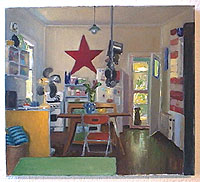| |
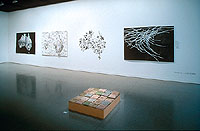
Susanna Castledon
Recipient
of the 2002 Galerie Düsseldorf, Curtin University, School of
Art, Post Graduate Scholarship.
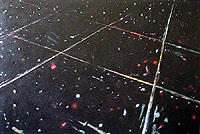
Kevin Robertson: An Overview

Kevin
Robertson: CLOUD PAINTINGS 2002 - 2003
A
solo exhibition of New Paintings
Through the open studio window, passing clouds draw their own shapes
across the city skyline. Inside the studio, and in real time, Kevin
Robertson eagerly studies their ever changing form as he draws them
into and onto a series of large canvasses - before they are gone forever.
Link
to Kevin Robertson: In Focus Artist for March 2003

July
2003
Richard
Gunning
Richard
Gunning's paintings reveal an intense interest in the aesthetic
possibilities of the interior spaces of studio and home. Focus is
upon the value and integrity of ordinary objects within these settings-a
shoe, ladder, chair, fruit, flowers. In the works (whether scrutinising
a few objects or an entire room) concentration is upon variety of
surface texture and compositional balance, aided by the unifying
(and often dramatic) effects of colour and light.
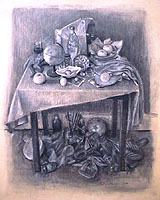
Drawing
for The Blue Table 2002
Charcoal
and conte on Paper
80
x 61 cm

Mike
Singe
"Are
we there yet" a solo exhibition of new work
"ARE WE THERE YET?"
"Are we their yet?" I wonder how many holiday juggernauts
have reverberated to these words, uttered by small humans suddenly
viewing unfamiliar landscapes from their elevated booster seats. Having
left familiar territory, they are now incapable of assessing accurately
the distance and scale of the journey they are suddenly undertaking.
How long will it be before the Promised Land is reached and how will
they recognize it when they get there? As a young child I remember
the amusement my patient parents derived from "Are we there yet?"
I seem to remember on one trip to Merredin uttering these words somewhere
just out of Midland. This statement was humorous to my parents because
of the innocent nature of my question (and because there was well
over two hundred kilometres to go).
As I grew older I stopped asking "Are we their yet?" I knew
where we were going and how long it would take to reach our destination.
As an adult I find myself less reassured about the world and "Are
we there yet?" has made its way back into my vocabulary. The
question now refers predominately to the quality of the destination
and whether it is worth the trip, rather than the distances involved.
Should we travel any further when the bitumen on which we have stopped
looks decidedly better than the loose gravel ahead?
Recently I have asked these same questions of the city I live in,
Perth, Western Australia. Perth seems to be growing at an alarming
rate, but I am not convinced it knows where it is headed. The exhibition
"Are we there yet?" takes a humorous look at the Perth Landscape
and asks the question "Is Perth there yet?"
In this exhibition you will find reproductions of everyday objects
meticulously made from the pages of Perth street directories. While
these objects represent the real thing their function has been denied
by the nature of the material used for their construction. These are
reproductions of static objects made from a material designed to aid
navigation through the Perth landscape. A metaphor perhaps for Perth’s
endless desire to move further out into the world even though it may
not have the appropriate means to do so. Denying the intended function
of an object permits an alternative function to be substituted in
its place. This new function allows for a more humorous view to be
taken on a subject, in this case the Perth Landscape. In this exhibition
a garden rake becomes a property developer, a closed venetian blind
shows you an expansive view of the Perth Landscape, and a loaf of
sliced bread becomes a land subdivision. Ultimately I am not sure
how far down the development highway Perth has travelled. Perhaps
the most important question to ask is where would be the best place
to stop. That place may be just around the bend or perhaps, in a race
to get there, has Perth taken a new bypass road and missed it altogether.
Finally, don’t take this statement too seriously. I think you
will find the work far more interesting than any statement I am able
to produce.
Link
to previous solo exhibition

August
2003
Brian
McKay
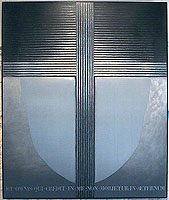
Winner
of the 2002 Mandorla Religious Art Prize
Howard
Taylor : Phenomena
Museum of Contemporary Art, Sydney
17 September – 30 November 2003
The Art Gallery of Western Australia
5 February – 2 May 2004
Curator:
Gary Dufour, Deputy Director, Art Gallery of Western Australia,
Perth
Catalogue Essayist: Russell Storer, Curator, Museum of Contemporary
Art, Sydney
This exhibition is supported by Visions of Australia, a Commonwealth
Government Program
supporting
touring exhibitions by providing funding assistance for the development
and touring of cultural material across Australia.
Lidija
Dombrovska Larsen
5
- 26 October 2003
Breakdown,
decay, transformation, weathering and most of all the passing of time.
All these aspects are part of the ongoing exploration of painting as
a metaphor for life, decay and renewal. The compost heap is as important
as an organised filing cabinet.
That is what this group of paintings is about
which
is a continuation of what I have been doing - what keeps me going.
(Galliano Fardin October 2003)
Artists
Represented :
James Angus, Su Baker, Eugenie Keefer Bell, Jon Cattapan, Susanna
Castelden, Douglas Chambers, Lesley Duxbury, Ernst Ellemunter, Sarah
Elson, Caspar Fairhall, Galliano Fardin, Pamela Gaunt, Joss Gregson,
Richard Gunning, Marie Hobbs, Bevan Honey, Jill Kempson, Lidija Dombrovska
Larsen, Brian McKay, Hilarie Mais, Allan Mitelman, Frank Morris, Tom
Müller, Jánis Nedéla, Louise Paramor, Jon Plapp
John Peart, Stuart Ringholt, Kevin Robertson, Megan Salmon, Douglas
Sheerer, Mike Singe , Ted Snell, Alex Spremberg, John Teschendorff,
Valerie Tring, Judith Wright,
The
Estate of Howard H Taylor, The Estate of David Watt
|
|

